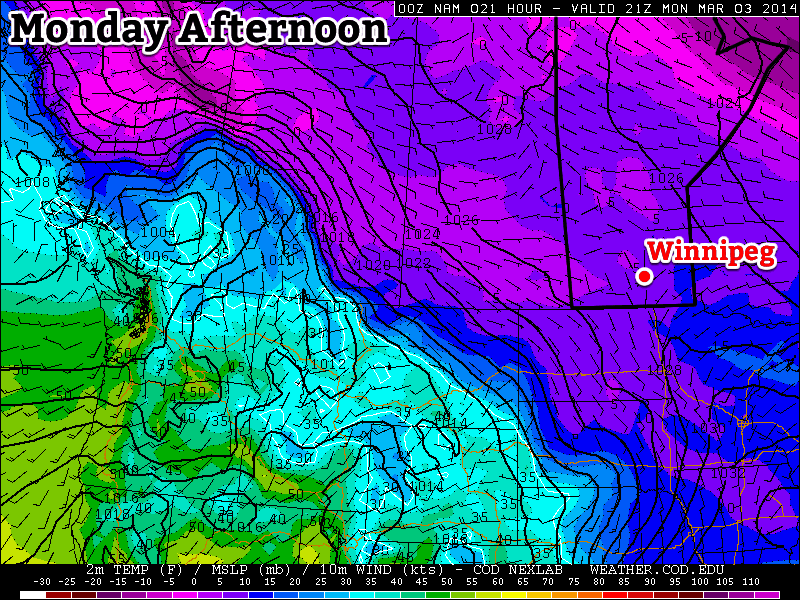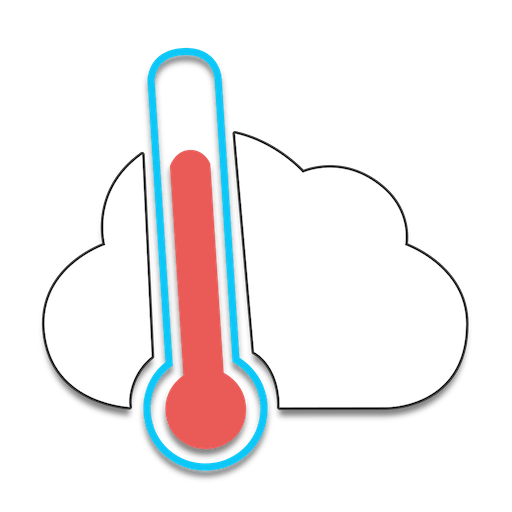Windier, snowier weather is on the way for Winnipeg and the Red River Valley, marking the start of a large-scale pattern shift which will bring the latest – and hopefully last – deep freeze to an end and allow more seasonal weather and temperatures to take hold.
A Windy, Snowy Shift
Warmer air trying to build its way into the Red River Valley will result in increasing southerly winds today. By early this afternoon, winds will be quite strong out of the south at 40-50km/h with gusts as high as 70km/h. These strong winds – coupled with a fairly deep boundary layer – will likely produce fairly widespread blowing snow in the Red River Valley. It’s severity may be limited by relatively mild temperatures, however it’s best that anyone travelling on area highways be prepared for poor driving conditions.

By late in the afternoon, the upper-level portion of the warm front will be approaching the Manitoba border. A strengthening jet[1] overriding the 850mb baroclinic zone will provide a fair amount of isentropic lift. As the jet intensifies, as will the area of light snow pushing into Parkland Manitoba this morning. It will progress eastwards through the day and push through the Interlake and Red River Valley mid-to-late this afternoon.
It seems likely that Winnipeg will see around 2cm of snow that falls as a fairly intense, but short, burst. Areas south of the city will be more hit and miss as to whether or not snow falls. The safe thing to say is that you’re more and more likely to see snow the further north you are in the valley.
By evening our temperature will climb up to our daytime high of about -9°C. Overnight will bring the continued chance for flurries/light snow while winds diminish somewhat and temperatures continue to rise to around -7 or -6°C here in Winnipeg.

Thursday looks to bring more snow to Winnipeg & the Red River Valley as a clipper system races along the Canada-US border. Snow will move in fairly early in the day, spreading eastwards along the Trans-Canada corridor into Winnipeg, and end early in the afternoon. In total, around 5cm is likely to fall through the morning hours – with a little less to the south of Winnipeg – while accompanied by breezy winds out of the south at around 30km/h. Winds will become gusty out of the NW at 30-50km/h in the afternoon as the system tracks off to our east.
Temperatures will climb to a positively balmy -2 or -1°C by midday before the northwesterlies begin drawing in cooler air.
Flurries & Cooler
Thursday night will bring a good chance of seeing some flurry activity as another ridge of high pressure builds in from the NW and some favourable snow-making air slides southeastwards through the region. Any accumulations would amount to only a couple cm at most, and through the night the clouds will break up and we’ll be left with partly cloudy skies by Friday morning.
Friday itself will bring cooler temperatures with a high of only around -12°C and light winds. Some cloud cover Friday night will help temperatures from dipping too much, with overnight lows dipping just below -20°C.
Spring Ahead?
Hope finally lies in the long-range models. Almost all are showing a high probability of a return to seasonal temperatures[2] within the next 2 weeks. No significant cold snaps are in the foreseeable future, and with the sun getting stronger and stronger and the days getting longer and longer, it doesn’t seem likely that we’ll see any more brutal cold snaps for the miserable winter of 2013-2014.
Don’t forget that this coming Sunday, March 9th at 2:00AM we get to do that wonderful[3] tradition of changing our clocks! We spring forward an hour, so it’ll be time to cash in that extra hour you banked way back in the fall!



